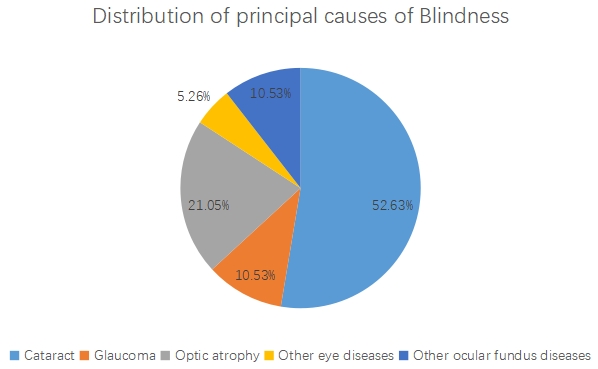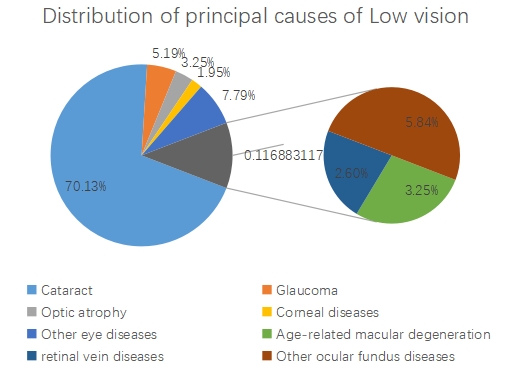1、Brown GC. Vision and quality-of-life. Trans Am ophthalmol soc. 1999, 97: 473–511. DOI: 10.1016/s0002-9394(00)00513-4Brown GC. Vision and quality-of-life. Trans Am ophthalmol soc. 1999, 97: 473–511. DOI: 10.1016/s0002-9394(00)00513-4
2、McCarty C, Nanjan MB, Taylor H. Vision impairment predicts 5 year mortality. Br J Ophthalmol. 2000, 85: 322-326. DOI: 10.1136/bjo.85.3.322McCarty C, Nanjan MB, Taylor H. Vision impairment predicts 5 year mortality. Br J Ophthalmol. 2000, 85: 322-326. DOI: 10.1136/bjo.85.3.322
3、Ramrattan RS. Prevalence and causes of visual field loss in the elderly and associations with impairment in daily functioning. Arch Ophthalmol. 2001, 119(12): 1788. DOI: 10.1001/archopht.119.12.1788Ramrattan RS. Prevalence and causes of visual field loss in the elderly and associations with impairment in daily functioning. Arch Ophthalmol. 2001, 119(12): 1788. DOI: 10.1001/archopht.119.12.1788
4、Leissner%20J%2C%20Coenen%20M%2C%20Froehlich%20S%2C%20et%20al.%20What%20explains%20health%20in%20persons%20with%20visual%20impairment%3F%20Health%20Qual%20Life%20Outcomes.%202014%2C%2012%3A%2065.%20DOI%3A%2010.1186%2F1477-7525-12-65Leissner%20J%2C%20Coenen%20M%2C%20Froehlich%20S%2C%20et%20al.%20What%20explains%20health%20in%20persons%20with%20visual%20impairment%3F%20Health%20Qual%20Life%20Outcomes.%202014%2C%2012%3A%2065.%20DOI%3A%2010.1186%2F1477-7525-12-65
5、GBD 2019 Diseases and Injuries Collaborators. Global burden of 369 diseases and injuries in 204 countries and territories, 1990-2019: a systematic analysis for the Global Burden of Disease Study 2019. Lancet. 2020, 396(10258): 1204-1222. DOI: 10.1016/S0140-6736(20)30925-9GBD 2019 Diseases and Injuries Collaborators. Global burden of 369 diseases and injuries in 204 countries and territories, 1990-2019: a systematic analysis for the Global Burden of Disease Study 2019. Lancet. 2020, 396(10258): 1204-1222. DOI: 10.1016/S0140-6736(20)30925-9
6、Xu T, Wang B, Liu H, et al. Prevalence and causes of vision loss in China from 1990 to 2019: findings from the global burden of disease study 2019. Lancet Public Health. 2020, 5(12): e682-e691. DOI: 10.1016/S2468-2667(20)30254-1Xu T, Wang B, Liu H, et al. Prevalence and causes of vision loss in China from 1990 to 2019: findings from the global burden of disease study 2019. Lancet Public Health. 2020, 5(12): e682-e691. DOI: 10.1016/S2468-2667(20)30254-1
7、Mu%C3%B1oz%20B%2C%20West%20SK.%20Blindness%20and%20visual%20impairment%20in%20the%20Americas%20and%20the%20Caribbean.%20Br%20J%20Ophthalmol.%202002%2C%2086(5)%3A%20498-504.%20DOI%3A%2010.1136%2Fbjo.86.5.498Mu%C3%B1oz%20B%2C%20West%20SK.%20Blindness%20and%20visual%20impairment%20in%20the%20Americas%20and%20the%20Caribbean.%20Br%20J%20Ophthalmol.%202002%2C%2086(5)%3A%20498-504.%20DOI%3A%2010.1136%2Fbjo.86.5.498
8、Bourne RA. Worldwide glaucoma through the looking glass. Br J Ophthalmol. 2006, 90(3): 253-254. DOI: 10.1136/bjo.2005.083527Bourne RA. Worldwide glaucoma through the looking glass. Br J Ophthalmol. 2006, 90(3): 253-254. DOI: 10.1136/bjo.2005.083527
9、Bourne R, Steinmetz JD, Flaxman S, et al. Trends in prevalence of blindness and distance and near vision impairment over 30 years: an analysis for the Global Burden of Disease Study. Lancet Glob Health. 2021, 9(2): e130-e143. DOI: 10.1016/S2214-109X(20)30425-3Bourne R, Steinmetz JD, Flaxman S, et al. Trends in prevalence of blindness and distance and near vision impairment over 30 years: an analysis for the Global Burden of Disease Study. Lancet Glob Health. 2021, 9(2): e130-e143. DOI: 10.1016/S2214-109X(20)30425-3
10、Zhao J, Ellwein LB, Cui H, et al. Prevalence of vision impairment in older adults in rural China the China nine-province survey. Ophthalmology. 2010, 117(3): 409-416.e1. DOI: 10.1016/j.ophtha.2009.11.023Zhao J, Ellwein LB, Cui H, et al. Prevalence of vision impairment in older adults in rural China the China nine-province survey. Ophthalmology. 2010, 117(3): 409-416.e1. DOI: 10.1016/j.ophtha.2009.11.023
11、Resnikoff S, Kocur I, Etya’ale DE, et al. Vision 2020: the right to sight. Ann Trop Med Parasitol. 2008, 102(sup1): 3-5. DOI: 10.1179/136485908x337409Resnikoff S, Kocur I, Etya’ale DE, et al. Vision 2020: the right to sight. Ann Trop Med Parasitol. 2008, 102(sup1): 3-5. DOI: 10.1179/136485908x337409
12、Li C, Zhu B, Zhang J, et al. Epidemiology, health policy and public health implications of visual impairment and age-related eye diseases in mainland China. Front Public Health. 2022, 10: 966006. DOI: 10.3389/fpubh.2022.966006Li C, Zhu B, Zhang J, et al. Epidemiology, health policy and public health implications of visual impairment and age-related eye diseases in mainland China. Front Public Health. 2022, 10: 966006. DOI: 10.3389/fpubh.2022.966006
13、Guan HJ. Present status and development of prevention of blindness and ophthalmic epidemiologic studies in China. Zhonghua Yan Ke Za Zhi. 2010. 46(10): 938-943Guan HJ. Present status and development of prevention of blindness and ophthalmic epidemiologic studies in China. Zhonghua Yan Ke Za Zhi. 2010. 46(10): 938-943
14、Wang W, Yan W, Fotis K, et al. Cataract surgical rate and socioeconomics: a global study. Invest Ophthalmol Vis Sci. 2016, 57(14): 5872. DOI: 10.1167/iovs.16-19894Wang W, Yan W, Fotis K, et al. Cataract surgical rate and socioeconomics: a global study. Invest Ophthalmol Vis Sci. 2016, 57(14): 5872. DOI: 10.1167/iovs.16-19894
15、Zhu MM, Zhu JF, Zou HD, et al. Analysis of cataract surgical rate and its influencing factors in Shanghai, China. Zhonghua Yi Xue Za Zhi. 2013, 93(47): 3737-3740Zhu MM, Zhu JF, Zou HD, et al. Analysis of cataract surgical rate and its influencing factors in Shanghai, China. Zhonghua Yi Xue Za Zhi. 2013, 93(47): 3737-3740
16、Song P, Wang H, Theodoratou E, et al. The national and subnational prevalence of cataract and cataract blindness in China: a systematic review and meta-analysis. J Glob Health. 2018, 8(1): 010804. DOI: 10.7189/jogh.08.010804Song P, Wang H, Theodoratou E, et al. The national and subnational prevalence of cataract and cataract blindness in China: a systematic review and meta-analysis. J Glob Health. 2018, 8(1): 010804. DOI: 10.7189/jogh.08.010804
17、Yan W, Wang W, van Wijngaarden P, et al. Longitudinal changes in global cataract surgery rate inequality and associations with socioeconomic indices. Clinical Exper Ophthalmology. 2019, 47(4): 453-460. DOI: 10.1111/ceo.13430Yan W, Wang W, van Wijngaarden P, et al. Longitudinal changes in global cataract surgery rate inequality and associations with socioeconomic indices. Clinical Exper Ophthalmology. 2019, 47(4): 453-460. DOI: 10.1111/ceo.13430
18、Zhang J, Zhang J, Zhang C, et al. Diabetic macular edema: current understanding, molecular mechanisms and therapeutic implications. Cells. 2022, 11(21): 3362. DOI: 10.3390/cells11213362Zhang J, Zhang J, Zhang C, et al. Diabetic macular edema: current understanding, molecular mechanisms and therapeutic implications. Cells. 2022, 11(21): 3362. DOI: 10.3390/cells11213362
19、Ma C, Li H, Lu S, et al. The role and therapeutic potential of melatonin in degenerative fundus diseases: diabetes retinopathy and age-related macular degeneration. Drug Des Devel Ther. 2024, 18: 2329-2346. DOI: 10.2147/DDDT.S471525Ma C, Li H, Lu S, et al. The role and therapeutic potential of melatonin in degenerative fundus diseases: diabetes retinopathy and age-related macular degeneration. Drug Des Devel Ther. 2024, 18: 2329-2346. DOI: 10.2147/DDDT.S471525
20、Liu H, et al. General Medical Management of Diabetic Retinopathy. Yan Ke Xue Bao. 2023, 38(04): 350-359.DOI:10.12419/j.issn.1000-4432.2023.04.07Liu H, et al. General Medical Management of Diabetic Retinopathy. Yan Ke Xue Bao. 2023, 38(04): 350-359.DOI:10.12419/j.issn.1000-4432.2023.04.07
21、Abdull MM, Chandler C, Gilbert C. Glaucoma, “the silent thief of sight”: patients' perspectives and health seeking behaviour in Bauchi, northern Nigeria. BMC Ophthalmol. 2016, 16: 44. DOI: 10.1186/s12886-016-0220-6.Abdull MM, Chandler C, Gilbert C. Glaucoma, “the silent thief of sight”: patients' perspectives and health seeking behaviour in Bauchi, northern Nigeria. BMC Ophthalmol. 2016, 16: 44. DOI: 10.1186/s12886-016-0220-6.
22、Jonas JB, Aung T, Bourne RR, et al. Glaucoma. Lancet. 2017, 390(10108): 2183-2193. DOI: 10.1016/S0140-6736(17)31469-1Jonas JB, Aung T, Bourne RR, et al. Glaucoma. Lancet. 2017, 390(10108): 2183-2193. DOI: 10.1016/S0140-6736(17)31469-1
23、Zhao JL. Changing the Status of Glaucoma as the Leading Cause of Irreversible Blindness. Yan Ke Xue Bao. 2021. 36(06): 389-392. DOI:10.3978/j.issn.1000-4432.2021.06.08Zhao JL. Changing the Status of Glaucoma as the Leading Cause of Irreversible Blindness. Yan Ke Xue Bao. 2021. 36(06): 389-392. DOI:10.3978/j.issn.1000-4432.2021.06.08
24、Bennett JL, Costello F, Chen JJ, et al. Optic neuritis and autoimmune optic neuropathies: advances in diagnosis and treatment. Lancet Neurol. 2023, 22(1): 89-100. DOI: 10.1016/S1474-4422(22)00187-9Bennett JL, Costello F, Chen JJ, et al. Optic neuritis and autoimmune optic neuropathies: advances in diagnosis and treatment. Lancet Neurol. 2023, 22(1): 89-100. DOI: 10.1016/S1474-4422(22)00187-9
25、M%C3%B6rchen%20M%2C%20Langdon%20T%2C%20Ormsby%20GM%2C%20et%20al.%20Prevalence%20of%20blindness%20and%20cataract%20surgical%20outcomes%20in%20Takeo%20Province%2C%20Cambodia.%20Asia%20Pac%20J%20Ophthalmol%20(Phila).%202015%2C%204(1)%3A%2025-31.%20DOI%3A%2010.1097%2Fapo.0000000000000061M%C3%B6rchen%20M%2C%20Langdon%20T%2C%20Ormsby%20GM%2C%20et%20al.%20Prevalence%20of%20blindness%20and%20cataract%20surgical%20outcomes%20in%20Takeo%20Province%2C%20Cambodia.%20Asia%20Pac%20J%20Ophthalmol%20(Phila).%202015%2C%204(1)%3A%2025-31.%20DOI%3A%2010.1097%2Fapo.0000000000000061
26、Afshari M, Moosazadeh M, Barzegari S, et al. Prevalence of blindness and low vision in Iran: a systematic review and meta-analysis. Ophthalmic Epidemiol. 2018, 25(4): 288-296. DOI: 10.1080/09286586.2018.1451547Afshari M, Moosazadeh M, Barzegari S, et al. Prevalence of blindness and low vision in Iran: a systematic review and meta-analysis. Ophthalmic Epidemiol. 2018, 25(4): 288-296. DOI: 10.1080/09286586.2018.1451547
27、Zhao J, Xu X, Ellwein LB, et al. Causes of visual impairment and blindness in the 2006 and 2014 nine-province surveys in rural China. Am J Ophthalmol. 2019, 197: 80-87. DOI: 10.1016/j.ajo.2018.09.011Zhao J, Xu X, Ellwein LB, et al. Causes of visual impairment and blindness in the 2006 and 2014 nine-province surveys in rural China. Am J Ophthalmol. 2019, 197: 80-87. DOI: 10.1016/j.ajo.2018.09.011
28、Eunice Amador Rosa M, Lozano Bustillo A, Espinoza Salvadó I, et al. Prevalence and causes of avoidable blindness in subjects over 50 years of age in Honduras. J Ophthalmic Vis Res. 2022, 17(2): 225-232.. DOI: 10.18502/jovr.v17i2.10794Eunice Amador Rosa M, Lozano Bustillo A, Espinoza Salvadó I, et al. Prevalence and causes of avoidable blindness in subjects over 50 years of age in Honduras. J Ophthalmic Vis Res. 2022, 17(2): 225-232.. DOI: 10.18502/jovr.v17i2.10794
29、Xie YT. Survey of Blindness and Causes Among Uygur Peasants Aged 60 and over in Kuche Country of Xinjiang[D]. Xinjiang Medical University. 2007Xie YT. Survey of Blindness and Causes Among Uygur Peasants Aged 60 and over in Kuche Country of Xinjiang[D]. Xinjiang Medical University. 2007
30、Li Y, Huang W, Qiqige A, et al. Prevalence and causes of blindness, visual impairment among different ethnical minority groups in Xinjiang Uygur autonomous region, China. BMC Ophthalmol. 2018, 18(1): 41. DOI: 10.1186/s12886-018-0705-6Li Y, Huang W, Qiqige A, et al. Prevalence and causes of blindness, visual impairment among different ethnical minority groups in Xinjiang Uygur autonomous region, China. BMC Ophthalmol. 2018, 18(1): 41. DOI: 10.1186/s12886-018-0705-6
31、Mashige KP, Ramklass SS. Prevalence and causes of visual impairment among older persons living in low-income old age homes in Durban, South Africa. Afr J Prim Health Care Fam Med. 2020, 12(1): e1-e7. DOI: 10.4102/phcfm.v12i1.2159Mashige KP, Ramklass SS. Prevalence and causes of visual impairment among older persons living in low-income old age homes in Durban, South Africa. Afr J Prim Health Care Fam Med. 2020, 12(1): e1-e7. DOI: 10.4102/phcfm.v12i1.2159
32、Selvarajah D, Kar D, Khunti K, et al. Diabetic peripheral neuropathy: advances in diagnosis and strategies for screening and early intervention. Lancet Diabetes Endocrinol. 2019, 7(12): 938-948. DOI: 10.1016/s2213-8587(19)30081-6Selvarajah D, Kar D, Khunti K, et al. Diabetic peripheral neuropathy: advances in diagnosis and strategies for screening and early intervention. Lancet Diabetes Endocrinol. 2019, 7(12): 938-948. DOI: 10.1016/s2213-8587(19)30081-6
33、Williamson TH. Artificial intelligence in diabetic retinopathy. Eye. 2020, 35(2): 684. DOI: 10.1038/s41433-020-0855-7Williamson TH. Artificial intelligence in diabetic retinopathy. Eye. 2020, 35(2): 684. DOI: 10.1038/s41433-020-0855-7
34、De Francesco T, Bacharach J, Smith O, et al. Early diagnostics and interventional glaucoma. Ther Adv Ophthalmol. 2024, 16: 25158414241287431. DOI: 10.1177/25158414241287431De Francesco T, Bacharach J, Smith O, et al. Early diagnostics and interventional glaucoma. Ther Adv Ophthalmol. 2024, 16: 25158414241287431. DOI: 10.1177/25158414241287431
35、Qin Z, Guo Z, Wang J. Effects of aerobic exercise on balance and mobility in individuals with visual impairment: a systematic review. Disabil Rehabil. 2024, 46(22): 5134-5143. DOI: 10.1080/09638288.2023.2288931Qin Z, Guo Z, Wang J. Effects of aerobic exercise on balance and mobility in individuals with visual impairment: a systematic review. Disabil Rehabil. 2024, 46(22): 5134-5143. DOI: 10.1080/09638288.2023.2288931





























